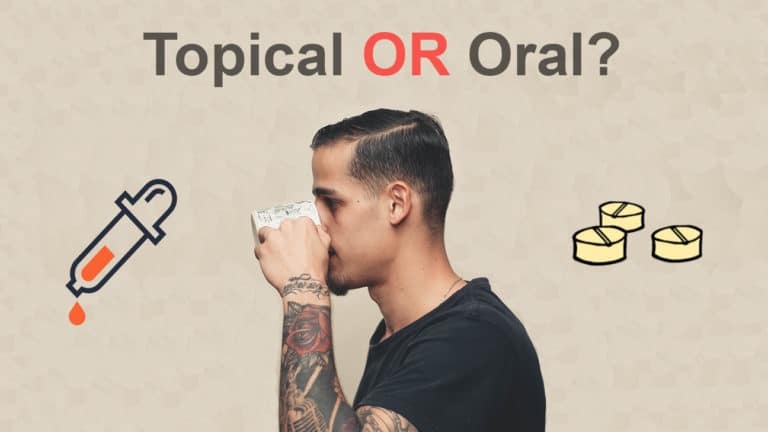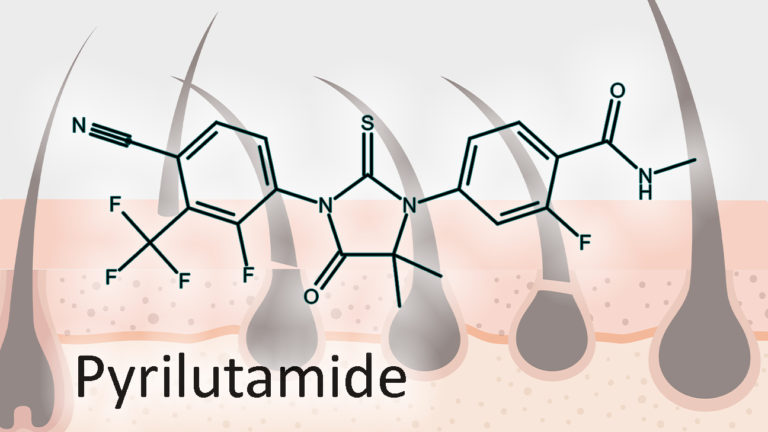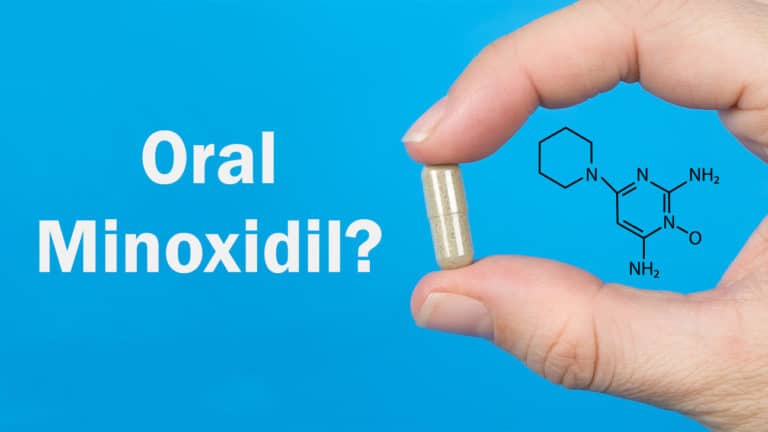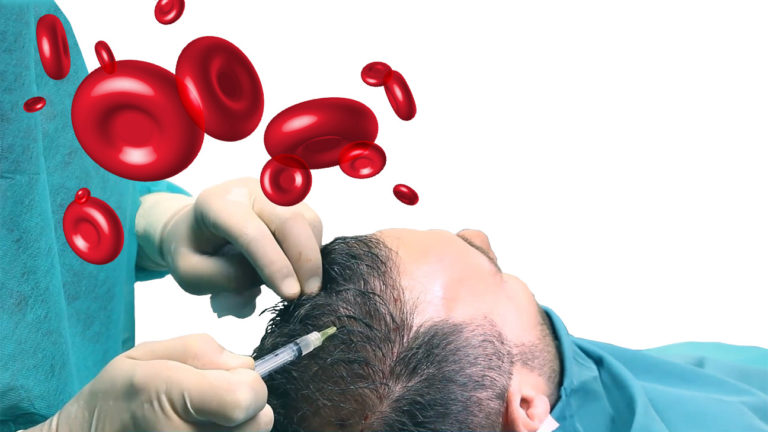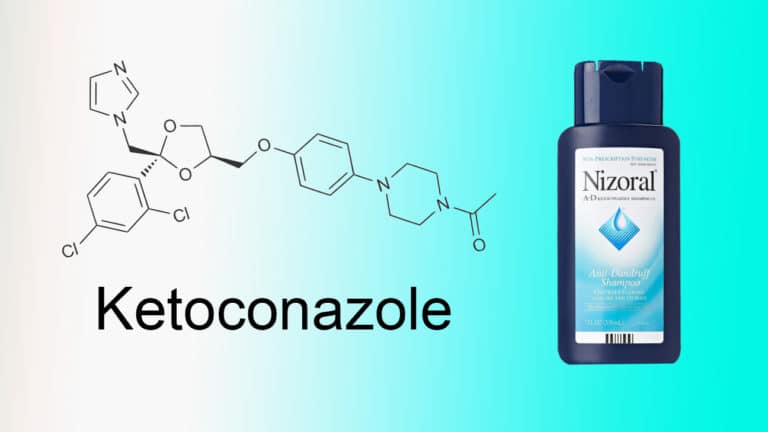High Strength Minoxidil: Does 10% and 15% Work Better?

If you buy something through a link on this page, we may earn a small commission. It does not affect the product price. Read our advertising policy.
If you are suffering from hair loss, then you have probably encountered this medication – minoxidil.
If you ever ask anyone a treatment option that they can recommend for your hair loss, they are very likely to mention minoxidil even without thinking.
But why is that so?
Ever since the therapeutic treatment of hair loss started gaining traction in the 1970s, minoxidil was chiefly the only go-to product.
And here is how it happened:
The amazing history of minoxidil
As far back as 1963, Upjohn pharmaceuticals developed a product which they believed could be very helpful in the treatment of high blood pressure. They named the product minoxidil. Consequently, the Food and Drug Administration (FDA) approved minoxidil in the year 1979, for use by patients who are suffering from high blood pressure.
However, a few adverse effects were noted soon after it was approved. The patients that were being treated with minoxidil started growing unwanted hairs. On realizing this, Upjohn decided to harness this side effect on developing a new mechanism to treat hair loss.
Long story short, several tests were done on the effects of minoxidil on hair growth, and that is how minoxidil started being used for the treatment of hair loss. Since then, it has become one of the most widely prescribed medications for hair loss. There are different minoxidil concentrations and solutions for the purpose of treating hair loss.
Minoxidil concentrations
Currently, there are four major solutions for minoxidil: 2 %, 5 %, 10 % and 15 %. There is also a modification of it with reduced molecule size – nanoxidil. When you see these different solutions, the questions that instantly come to mind are:
Does it really matter which strength you use? Does the extra strength of minoxidil have any effect on the results you expect?
These are the questions we will be exploring henceforth. But do you know? Of the four solutions of minoxidil, only 2 % and 5 % solutions are approved by the FDA for the treatment of hair loss.
Studies that compare the 10 % and 15 % minoxidil are limited. However, those that compare the lower solutions (2 % and 5 %) have results that may help establish a fruitful hypothesis about how the minoxidil 10 % and 15 % minoxidil work.
Minoxidil 2 % vs. 5 %
In the year 2002, a randomized trial compared 2 % and 5% minoxidil. This study was set to evaluate the effectiveness of these solutions in the management of varying degrees of hair loss in male test subjects.
The study involved a group of 393 men who were categorized into three groups: those receiving 2 %, those receiving 5 %, and the placebo group. All these men were studied for a period of 48 weeks.
Baseline measurements were obtained at the very beginning of the study. Subsequently, measurements were taken once every four weeks until the 32nd week, followed by evaluation every eight weeks after that.
As the study progressed, one particular aspect of the results stood out. Those test subjects who were being treated with minoxidil 5 % showed better results than those using 2 % minoxidil.
Change from baseline in hair count – minoxidil 5 %, 2%, and placebo

When considered in terms of results, the study above clearly agrees that 5 % minoxidil is way better than 2 % minoxidil in the treatment of hair loss.
Minoxidil 5 % vs. 10 %
On the other hand, another recent study that compared the efficiency of 5 % and 10 % minoxidil in the treatment of androgenetic alopecia, came up with contradicting findings.
A randomized study involved 90 male subjects with androgenetic alopecia. They were divided into three groups: (a) applied 5 % minoxidil, (b) applied 10 % minoxidil, (c) placebo group. After 36 weeks it was found out that 5 % minoxidil performed better in terms of hair regrowth (hair counter per square cm). What is more, the 10 % minoxidil group reported more skin iteration cases.
Below you can see the comparison of subjects from both, 5 % and 10 % groups, who demonstrated significant improvement:

Minoxidil 5 % vs. 15 %
One of the first studies to examine 15 % minoxidil for hair loss treatment was conducted in 2016. The subjects of a trial were females with pattern hair loss, who were non-responders to a 5 % minoxidil.
At the end of the 12-weeks treatment period with 15 % minoxidil topical solution, 60 percent of women responded to the treatment and saw a significant increase in hair counts (>13.7 % on avg.). What is more, no significant side effects were reported during the trial.
Dose-response of 10 % and 15 % minoxidil
A low amount of clinical trials makes it difficult to come up with a consensus on the most efficient concentration of minoxidil. What is more, existing studies provide quite varying results, which to some degree suggests that results highly depend on the individual.
The sulfotransferase enzyme expression, which determines how well minoxidil works for you, is variable among individuals. Some may have low levels, causing them to become non-responders.
However, we can use the results available on 2 % vs. 5 % solutions to extrapolate a hypothesis. It suffices to note that this rule of dose-response doesn’t apply to all medications though minoxidil seems to follow this rule.
The law of diminishing returns applied to minoxidil
You may ask: why don’t you use a higher concentration of minoxidil, if the higher it is, the better the results? Well, it doesn’t work that way with all medications.
Therefore, as much as 15 % minoxidil may be effective, you are more likely to experience side effects compared to using lower concentrations such as 5 % or 2 %.
Moreover, some medications (of which minoxidil is one) reach a point where a further increase in the dose may not lead to a corresponding increase in the therapeutic effects of the drug. This is the law of diminishing returns. And with minoxidil, this law could theoretically start kicking in at about 7.5 % concentration where the results could begin to plateau.

This is because minoxidil is not soluble in water. Maximum solubility in propylene glycol is at 7.5%, beyond which it crystallizes more easily.
As a result, there may be not much difference between minoxidil 10 % and 15 % in terms of the desired therapeutic effect. However, minoxidil 15 % could outweigh the 10 % in terms of side effects.
The side effects with increased concentration of minoxidil
Here is something that will throw you into a little controversy. The active ingredient in minoxidil, minoxidil sulfate, is not so harmful, even though higher minoxidil levels in the blood can cause hypotension.
Now here is the catch:
Where do the side effects come from if the active ingredient is safe? The mystery lies within the non-active ingredients such as propylene glycol and alcohol. When you increase the dosage of minoxidil, it also means that you are increasing the concentration of these non-active yet harmful ingredients.
Also, a 5 % formulation is FDA approved for only once daily use in women, specifically the foam formulation as formulation contains propylene glycol which is more responsible for side effects.
Has this phenomenon been proven by studies? Of course!
This 2004 study that was previously mentioned, highlights that the side effects that were observed among the test subjects using 5 % minoxidil included intense pruritus, local irritation, and hypertrichosis (excessive growth of hair), especially in women, where this is a distressing side effect.
These side effects were determined to be caused by the non-active ingredients of minoxidil. If 5 % minoxidil yielded these side effects, how much should be expected with minoxidil 10 percent or 15 percent minoxidil?
As common with all other therapeutic agents, the more the dose, the better the result – but, the side effects will also increase significantly. So you need to understand the possible side effects of minoxidil and especially, higher concentrations of it. Other effects may include:
Price and availability of high strength minoxidil
Minoxidil is found in quite some drug stores, both online and in physical stores. You can also get it as a prescription from your doctor, however, it is quite hard to find stores where extra strength minoxidil is sold.
Currently, one of the options is to purchase extra strength minoxidil online. Products range from 2 % minoxidil to 15 %. That gives you the freedom to choose your desired minoxidil and give it a try for higher concentration solutions.
Consider buying from original manufacturers rather than from re-sellers to ensure that you get what is promised. Links for high strength minoxidil are provided below.
The price may vary depending on the store you are purchasing it from as well as the concentration. However, prices between $30 and $50 per 2 oz bottle are common.
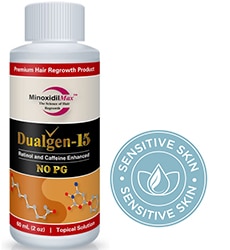
DualGen-15, NO PG
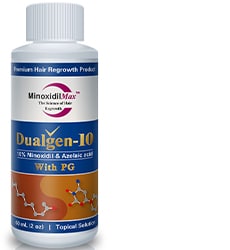
DualGen-10 With PG
Conclusion
For the treatment of hair loss, the FDA has only approved the 5 % and the 2 % minoxidil. The other concentrations are not approved. However, you might find them through a prescription.
Most people agree that lower doses work as well for them. If your minoxidil is not working the way you expect it to, then you should try out a stronger formulation or consult your doctor or seek other alternative treatments for hair loss.
Minoxidil is more effectively used in combination with other hair loss treatments rather than being used alone. Thus, other hair loss treatment options should be also considered.
